“I confess I do not believe in time. I like to fold my magic carpet, after use, in such a way as to superimpose one part of the pattern upon another. Let visitors trip. And the highest enjoyment of timelessness―in a landscape selected at random―is when I stand among rare butterflies and their food plants.- nabokov
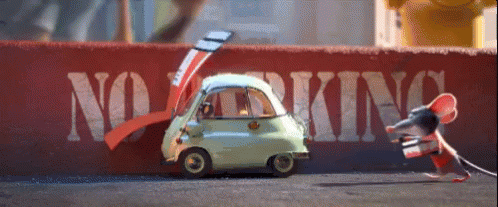
Friday, May 2, 2025
Wednesday, April 23, 2025
Remember Oleksandr Oles 1931
Remember
Oleksandr Oles
1931
When fighting invaders for the right to exist,
Ukraine was living, suffering, and dying,
Sympathy – all it was waiting for,
But Europe was silent.
When bleeding to death in an unequal fight,
And crying its eyes out in anguish,
Ukraine was waiting for help from its friends,
But Europe was silent.
When chained and exhausted and being enslaved,
Wounded Ukraine was screaming in terror,
When even rocks were moved by its pain,
But Europe was silent.
When gathering harvest soaked in blood,
And giving it all to the ruthless tyrant,
Dying from famine, Ukraine lost its voice,
But Europe was silent.
When Ukraine cursed its life, that turned into a grave,
Filled with endless death and violence,
When even the devil was crying in grief,
– Europe was silent.
Lina Kostenko (1930-present) – is a Ukrainian poet, journalist, writer, and leading member of the Sixtiers poetry movement in Ukraine, which was against Soviet totalitarianism and focused on protecting Ukrainian culture and language. Kostenko’s work was not published for many years due to her pro-Ukrainian views and activism. Many members of the Sixtiers movement were arrested, sent to prison camps, and killed. Despite everything, Lina Kostenko continued to write and is considered one of the most prominent Ukrainian poets.
A commandment Vasyl Sagaydak 1990
A commandment
Vasyl Sagaydak 1990
Never let a barbarian on your doorstep, my son –
No matter if he comes with war or with sweet vows.
He will take your house, your bed, and your wife,
And will burn all your books at maidan.
He will bury your language in vocabularies and graves,
And everything you have right now, my son,
He will reweave thread by thread, rewrite word by word,
Rebuild stone by stone, and claim as his own.
*Maidan is a town square. The word originated in the Persian language and came to Ukraine from the Crimean Tatar language.
Oleksandr Oles (1878–1944) – a Ukrainian writer, poet, translator, and activist. Due to persecution for his pro-Ukrainian views, he was forced into immigration to Vienna. There, he headed the Union of Ukrainian Journalists and edited the Ukrainian magazine. His son, Oleh Olzhych, was a Ukrainian poet and political activist who returned to Ukraine and became head of the cultural branch of Organization of Ukrainian Nationalists. For his pro-Ukrainian position, he was arrested, tortured, and killed in 1944.
Saturday, April 19, 2025
Soviet Refuses Permission to Manufacture Matzo in Moscow
Soviet Refuses Permission to Manufacture Matzo in Moscow
Permission for opening a single Matzo bakery in Moscow, which the organized Jewish community of Moscow had planned to erect on the site of the Jewish cemetery is not forthcoming. The application was made some time ago and it had been hoped that the Soviet authorities would accede to the request.
The rejection of the application for permission to manufacture Matzo here threatens Russian Jewry with a Matzoless Passover. The authorities base their refusal not on anti-religious discrimination, but on the decision of the Moscow Soviet to grant no patents for bakeries run by private individuals, such as the organized Jewish community is at present considered to be.
It is believed, however, that the real cause of the refusal is the agitation carried on in the Yiddish Communist press against Jewish institutions abroad for devoting so much attention to the condition of starvation of Russian Jewry. The Yiddish Communist press has stigmatized the campaign for the provision of Matzo for Russian Jewry as part of the foreign campaign for intervention aaginst the Soviets. It demands an intensification of the fight against religion.
Thursday, April 17, 2025
Tell Me a Fractal Geoffrey DuttonMay 17, 20225 minute read
“What I hope this book now will leave behind: the idea that new patterns like spirals or explosions or vortex streets might open our eyes to other natural shapes underlying our stories, might let us step away from the arc sometimes, slip under or through that powerful wave, glorious as it can be. I hope that other patterns might help us imagine new ways to make our narratives vital and true, keep making our novels novel.”
Jane Alison, Meander, Spiral, Explode: Design and Pattern in Narrative, Catapult, 2018, pages 248-9.
Think of a snowflake forming around a molecule of water clinging to a tiny particle of something, how it blossoms and diverges as other molecules join in, seeking their hexagonal destiny, becoming a perfect thing of beauty. Then think of it melting, its sharp edges blurring, its interstices blotting out until it plops to earth. That’s a story, right there, in full surround. Matter, space and time at play.
The last two sentences in Jane Alison’s brief book, quoted above, hint at a broader range of spatial patterns that authors she discusses have deployed in fiction. She sees fractals, meanders, networks and other geometric structures as literary armatures that can supplant or coexist with the conventional Aristotelian beginning-middle-end story arc.
Ever since its publication, I’ve considered starting a sequel to my novel Turkey Shoot but felt stymied because no plot seemed to gel. I had what could be its central protagonist and vague ideas about her situation, but no idea what ought to happen, or even a location or time frame for the story. Perhaps, I thought upon reading Alison’s approach to story craft, I should think different. Meander, Spiral, Explode might help me wend my way around my writer’s block.
But how to build spatial metaphors into my nascent novel in an organic way, not as literary gimmicks? They could, I hoped, serve as scaffolding for expressing themes across different locals, scenes, characters, and subplots, on which to build a narrative structure in the fullness of space-time. Embracing spatial metaphors and analogs might prevent me from rolling out a story like a reel of audiotape.
A tape player (remember them?) has two rotating reels, one full and one empty to begin with. In between them sits a component called a “head” that “reads” electrical patterns on the tape as it is drawn at a steady pace by the “take-up” reel, just as we read by flipping pages of a book from one side to the other.
Sounds and images on tape unwind. Wound up, a tape forms a spiral and a book a stack whose narrative generally obeys Aristotle’s poetics but doesn’t need to. You can lose yourself in a book or a tape, but should you skip around in it you may get lost and fragment the experience. But instead of static tape heads, suppose readers were higher-dimensional beings able to leap along the spiral or radially to other tracks. In fact, many novels take readers back and forth through time space. You can think of a work of music or literature as a matrix of content that only seems to move and change because you navigate sequentially through it. Be it a story or a symphony, its creator ought to contrive that experience by elaborating themes with an architecture that gives delight.
Any of the structures that Alison cribs from geometry—she explores waves, wavelets, meanders, spirals, explosions, networks, fractals, and tsunamis—can be metaphorically deployed as literary devices in a novel or even a short story, probably in poetry too. Take snowflakes, which are both “explosions” and “fractals,” forms that authors whose prose she deconstructs seem to have analogized in narratives. Explosions, such as events from which many consequences radiate, are not uncommon. Fractals are harder to write and recognize in prose. Mathematical fractals[1] are “self-similar” objects generated from a seed that replicates into a mosaic-like pattern through time and space and across scales; as you zoom in or out, you see more of the same thing in every nook and cranny.
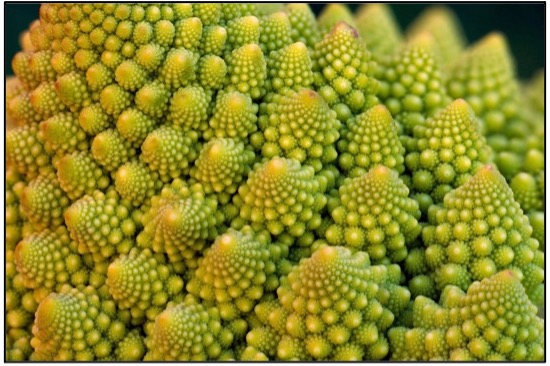
Fractals aren’t just equations. Forces of nature spontaneously generate all sorts of them. True to themselves, snails and sunflowers spiral, rivers and trees branch, coastlines and mud flats crinkle. But how many works of literature manifest such holistic qualities beyond displaying a consistent, self-similar style? To evoke them in writing seems difficult and perhaps unnatural, but it’s possible. Jane Alison believes David Mitchell’s Cloud Atlas is somewhat fractal; she also sees in it a tsunami. It’s a set of stories structured with palindromic symmetry—12345654321: “six long stories, one nested in the next” that “run from the 1850s into a shattered far future, and each story features someone who is weak and others who are monstrously powerful.” The first five are revisited in reverse order following the central futuristic one, “the only one told whole.” But each of its “cells,” she writes, “has its own texture and colors, and each makes the same sort of moves.”
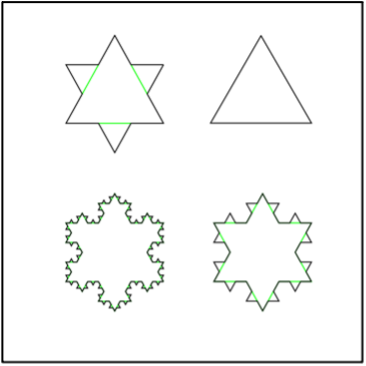
Turkey Shoot has few fractal qualities. But that doesn’t mean that a sequel need follow suit. It could ramify like a Koch snowflake, successively elaborating a simple shape to generate more intricate narrative detail. For example, consider a multigenerational family saga in which each cohort recapitulates or elaborates stories of those who have gone before.
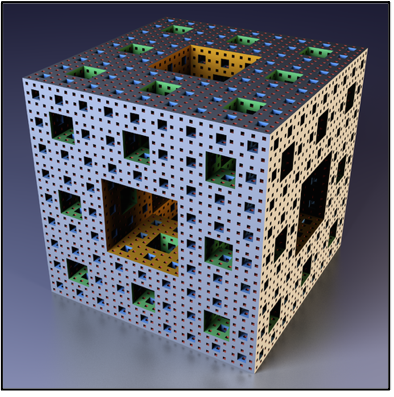
Or, like a Menger Sponge, a narrative could hollow out a prism of space-time with similar adjacent incidents, densifying until they almost merge. Think how an edict issuing from an outside power, say a central bank demanding austerity measures, can erode a nation-state. Its central bank is hit first, successively afflicting provinces, cities and then neighborhoods, families, and individuals. What was writ large comes home to roost.
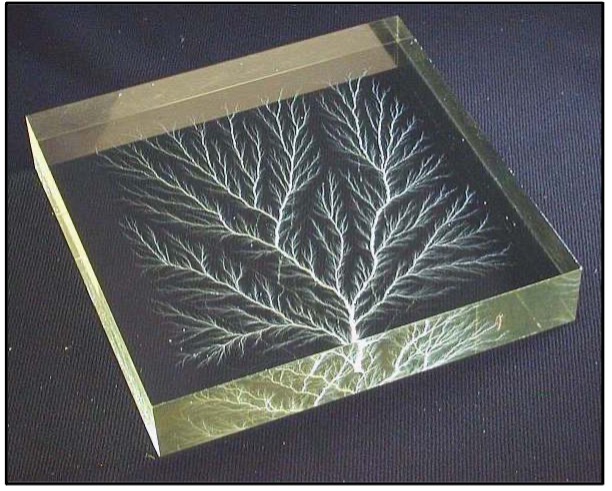
Draining static electricity from the base of an acrylic block sculpted this lacy fractal. These Lichtenberg figures branch just as trees, rivers, and blood vessels do to efficiently convey nutrients. Now consider nutrients as thoughts from different origins converging into ideas, or utterances meeting to form conversations. They continue to merge with others, building larger and larger narratives. Interactions at branching points are one-way or two-way dialogs between partners, friends, strangers, or enemies that can be friendly, casual, formal, or heated. Imagine an account of a horde of cops busting a street demonstration, each seizing a protester, corralling them in small groups that they hustle into a paddy wagon that drops them at a holding pen to join other captured protesters. That’s just how rivers channel precipitation.
I don’t know if I’ll pull off that novel or not, but I’m more likely to try having read Meander, Spiral, Explode. If you’ve been struggling to write a story, collection, or novel, pick up a copy and see where its patterns take your imagination.
Friday, April 4, 2025
Existence..... what a strange word
Existence..... what a strange word. He, set out by determination & curiosity, knows no existence, knows nothing realevent to himself. The petty destinations of others & everything on this world, in this world, he knows the answers to. Yet they have no purpose to him. He seeks knowledge of the unthinkable, of the indefineable, of the unknown. He explores the everything...using his mind, the most powerful tool known to him. Not a physical barrier blocking the limits of exploration, time thru thought thru dimensions.... the everything is his realm. Yet, the more he thinks, hoping to find answers to his questions, the more come up. Amazingly, the petty things mean much to him at this time, how he wants to be normal, not this transceiver of the everything. Then, ocuring to him, the answer. How everything is connected yet seperate. By experiencing the petty others' actions, reactions, emotions, doings, [scribble] and thoughts, he gets a mental picture of what, in his mind, is a cycle. Existence is a great hall, life is one of the [scribble] rooms, death is passing thru the doors, & the ever-existant compulsion of everything is the curiosity to keep moving down the hall, thru the doors, exploring rooms, down this never-ending hall. Questions make answers, answers conceive questions, and at long last he is content.
Thursday, March 27, 2025
“October” by W.S. Merwin
I remember how I would say, “I will gather
These pieces together,
Any minute now I will make
A knife out of a cloud.”
Even then the days
Went leaving their wounds behind them,
But, “Monument,” I kept saying to the grave,
“I am still your legend.”
There was another time
When our hands met and the clocks struck
And we lived on the point of a needle, like angels.
I have seen the spider’s triumph
In the palm of my hand. Above
My grave, that thoroughfare,
There are words now that can bring
My eyes to my feet, tamed.
Beyond the trees wearing names that are not their own
The paths are growing like smoke.
The promises have gone,
Gone, gone, and they were here just now.
There is the sky where they laid their fish.
Soon it will be evening
The Box is a bit like The Matrix.
The Box is a bit like The Matrix.
What The Box essentially represents is the societal paradigm of a structured ‘life existence’ framework. Within the confines of The Box’s parameters, he defines the present, limited human hierarchical order in this this current existence. Yes, I know that was a mouthful – sorry about that but bear with me. 😉
Inside of the large ‘Existence Box’ there is a division of boxes within boxes. Dylan further defines a total of four box subset groups as the “limitations”. Each is a box within a box spanning outward smallest to largest in space. The smallest box being the most densely populated and each consecutive one has acquires larger space yet becomes more sparsely populated. Even though all boxes are encompassed under one large box (of Existence), Dylan points out that there is ‘limitation’ as each is a group divided from the other: inclusive to those within each box and exclusive to those outside of each box. The first box is densely populated and labeled “Most” but it’s also the smallest box. In short, it includes many but it’s small in space. This signifies that the acceptable majority within society are also the most select, exclusive group and tucked away within the corner of the box almost as if it’s harder to obtain that special, designated space. There are many within it but it will only hold, or include, so many citizens that are ‘lucky’ enough to be deemed a part of it’s community. It is also the smallest box in the literal sense because it represents the small minded sorts that rely on thinking inside the box at the most limited, confining sense of existence. Spanning out from the smallest, elite “Most” box is the larger box defined as “Some”. This grouping is next in line to have a sense of belonging in a fairly acceptable existence group yet the box is a bit larger, less crowded (like the cattle or herd of “Most” )and more liberal in space but also in terms of societal rules and regulations. Outside of “Some”, are the “Few”. This third box essentially represents ‘the outcasts’ category from the two previous acceptable degrees of the societal majority. The “Some” have a esser sense of community or belonging here inside “Existence” but it’s also a larger box and containing the free-thinker, the unconventional citizens embracing less acceptable liberal minded views to that of the herd mentality of the “Most/Few” society. While the ‘Some’ are misfits they have their own opposing brand of ‘special’ to the elite “Most”; they are unique individualists that think for themselves and do not follow the masses. They do not need a mass of others to set the rules and help define them. Outside the “Few” is the vast box of “None” which represents…..no one… it is the no man’s land of “the nobodies”, the “nothings” , the bottom-of-the-barrel losers of society that don’t even amount to a mere blip on the radar of human societal existence.
Monday, March 17, 2025
-
A commandment Vasyl Sagaydak 1990 Never let a barbarian on your doorstep, my son – No matter if he comes with war or with sweet vows. He w...
-
Certificate of Live Birth Jasmine Reid You arrive on a Friday, with hail & vast moving grey above small window of white light, as a wo...
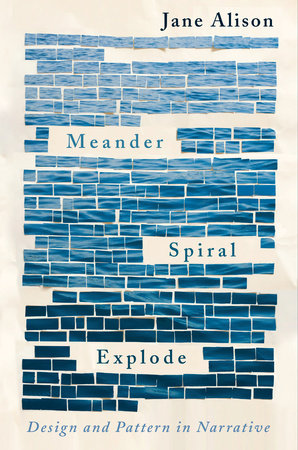

.png)